The MSI Z170A Gaming M7 Review: The Step Up to Skylake
by Ian Cutress on September 21, 2015 12:30 PM EST- Posted in
- Motherboards
- Gaming
- MSI
- Skylake
- Z170
Gaming Performance 2015
Our 2015 gaming results are still relatively new, but the issue of FCLK settings might play a big role here. At launch, the default setting for the communication buffer between the CPU and PCIe stack was 800 MHz, even though Intel suggested 1000 MHz, but this was because of firmware limiations from Intel. Since then, there is firmware to enable 1000 MHz, and most motherboard manufacturers have this - but it is unclear if the motherboard will default to 1000 MHz and it might vary from BIOS version to BIOS version. As we test at default settings, our numbers are only ever snapshots in time, but it leads to some interesting differences in discrete GPU performance.
Alien: Isolation
If first person survival mixed with horror is your sort of thing, then Alien: Isolation, based off of the Alien franchise, should be an interesting title. Developed by The Creative Assembly and released in October 2014, Alien: Isolation has won numerous awards from Game Of The Year to several top 10s/25s and Best Horror titles, ratcheting up over a million sales by February 2015. Alien: Isolation uses a custom built engine which includes dynamic sound effects and should be fully multi-core enabled.
For low end graphics, we test at 720p with Ultra settings, whereas for mid and high range graphics we bump this up to 1080p, taking the average frame rate as our marker with a scripted version of the built-in benchmark.
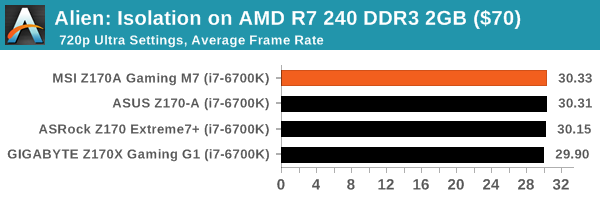
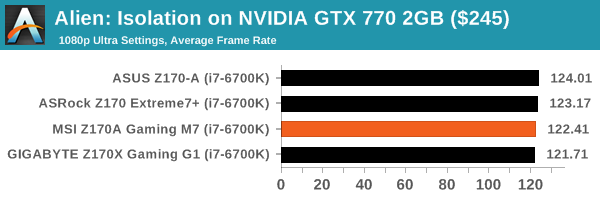
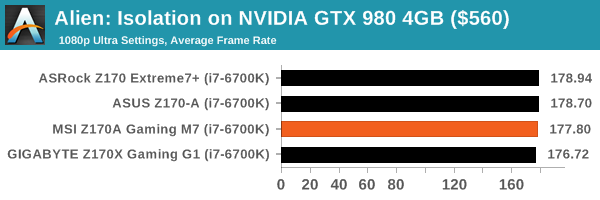
Total War: Attila
The Total War franchise moves on to Attila, another The Creative Assembly development, and is a stand-alone strategy title set in 395AD where the main story line lets the gamer take control of the leader of the Huns in order to conquer parts of the world. Graphically the game can render hundreds/thousands of units on screen at once, all with their individual actions and can put some of the big cards to task.
For low end graphics, we test at 720p with performance settings, recording the average frame rate. With mid and high range graphics, we test at 1080p with the quality setting. In both circumstances, unlimited video memory is enabled and the in-game scripted benchmark is used.
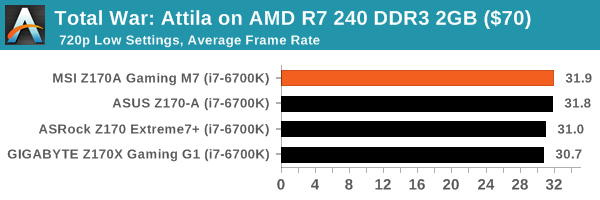
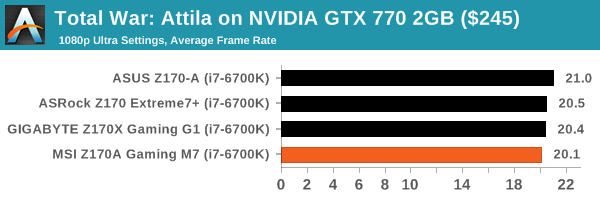
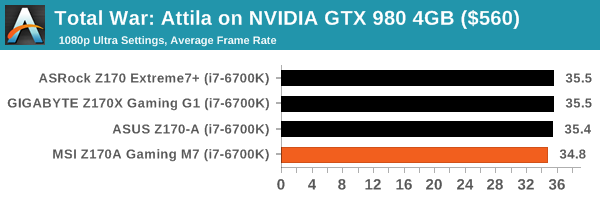
Grand Theft Auto V
The highly anticipated iteration of the Grand Theft Auto franchise finally hit the shelves on April 14th 2015, with both AMD and NVIDIA in tow to help optimize the title. GTA doesn’t provide graphical presets, but opens up the options to users and extends the boundaries by pushing even the hardest systems to the limit using Rockstar’s Advanced Game Engine. Whether the user is flying high in the mountains with long draw distances or dealing with assorted trash in the city, when cranked up to maximum it creates stunning visuals but hard work for both the CPU and the GPU.
For our test we have scripted a version of the in-game benchmark, relying only on the final part which combines a flight scene along with an in-city drive-by followed by a tanker explosion. For low end systems we test at 720p on the lowest settings, whereas mid and high end graphics play at 1080p with very high settings across the board.


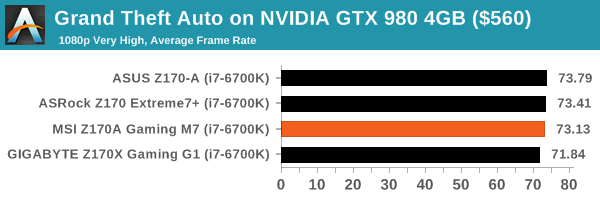
GRID: Autosport
No graphics tests are complete without some input from Codemasters and the EGO engine, which means for this round of testing we point towards GRID: Autosport, the next iteration in the GRID and racing genre. As with our previous racing testing, each update to the engine aims to add in effects, reflections, detail and realism, with Codemasters making ‘authenticity’ a main focal point for this version.
GRID’s benchmark mode is very flexible, and as a result we created a test race using a shortened version of the Red Bull Ring with twelve cars doing two laps. The car is focus starts last and is quite fast, but usually finishes second or third. For low end graphics we test at 1080p medium settings, whereas mid and high end graphics get the full 1080p maximum.

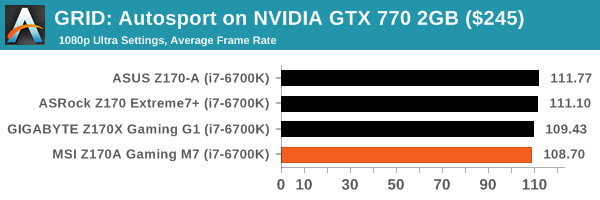

Middle-Earth: Shadow of Mordor
The final title in our testing is another battle of system performance with the open world action-adventure title, Shadow of Mordor. Produced by Monolith using the LithTech Jupiter EX engine and numerous detail add-ons, SoM goes for detail and complexity to a large extent, despite having to be cut down from the original plans. The main story itself was written by the same writer as Red Dead Redemption, and it received Zero Punctuation’s Game of The Year in 2014.
For testing purposes, SoM gives a dynamic screen resolution setting, allowing us to render at high resolutions that are then scaled down to the monitor. As a result, we get several tests using the in-game benchmark. For low end graphics we examine at 720p with low settings, whereas mid and high end graphics get 1080p Ultra. The top graphics test is also redone at 3840x2160, also with Ultra settings, and we also test two cards at 4K where possible.
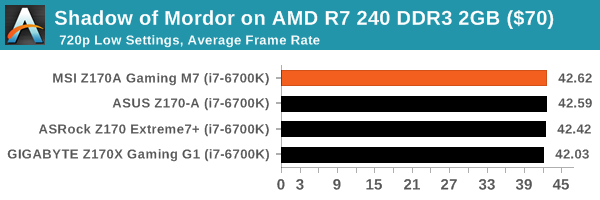
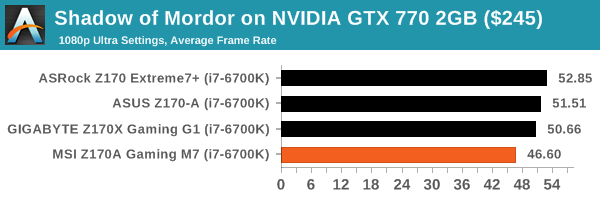
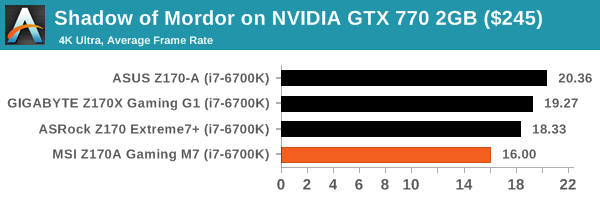
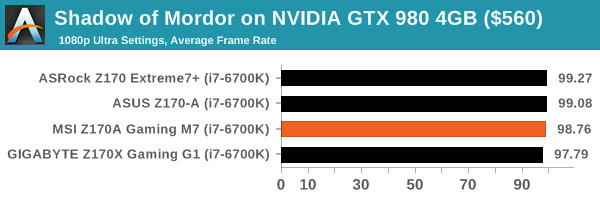
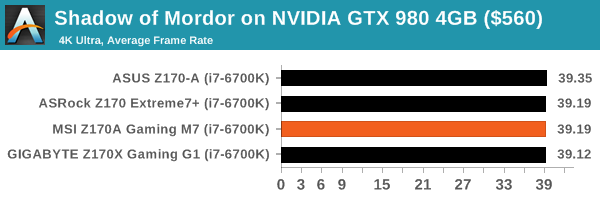
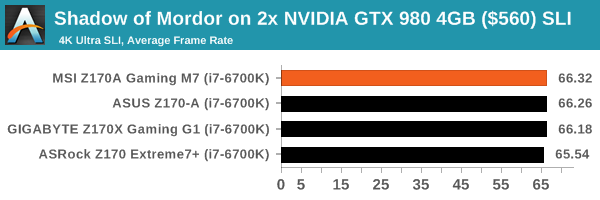















56 Comments
View All Comments
tygrus - Tuesday, September 29, 2015 - link
Check RAM and contact the shop you bought the MB from. You can ask for them to check the MB (and other components bought from them) and may be ask to swap the MB if you think it's the guilty component.Morawka - Monday, September 21, 2015 - link
I love the motherboard but i cant get by with only that few usb ports on the back... Mouse, Keyboard, Printer, Xbox 360 wireless adapter, UPS and i'm full (and that's using every type a port on the back). Still need room for Wireless AC adapter, and a full time backup USB 3.0 External HDD. hate to use the front ports for any of the stuff i mentioned above.I guess if you don't mind having a hub taking up space on your desk, and all the cable clutter that comes with it, then this board is for you.. My monitors even have usb 3.0 hubs but i am really hesitant to use them since they don't work when the monitor goes into standby.
With all that said, this is a amazing looking board.. I love the high quality PCI Express headers, and the Red Memory wire traces. that is sick. All other i/o options look ok as long as your not rolling DVI monitors.. to this day, display port still has tons of issues related to hotplugging. when you turn your monitor off, it thinks it's totally disconnected. DVI doesn't do that. Some power saving profiles and standby settings can really screw up display port driver, causing you to have to swap ports to get the monitor back on.
Captmorgan09 - Monday, September 21, 2015 - link
You could always use a front panel USB adapter like this to give you more USB options on the back. http://www.newegg.com/Product/Product.aspx?Item=9S...Impulses - Monday, September 21, 2015 - link
You're telling me... I have a UPS, keyboard (x2 ports), backup HDD, and a display hub connected directly...Then I've got the mouse connected to that keyboard and off the one display hub I've got two other display hubs; THEN on those two there's some non essentials like desk lighting strips, webcam, Bluetooth dongle, and wireless mouse dongle.
Leaves me with one free Type C port on the back, one on the displays, and then the front ports.
Luckily the ASUS Z170 board I chose has a decent number of front headers (2x 3.0 & 1x 2.0 IIRC) despite only having 6x on the back, so I have those free for a card reader, game pads, thumb drives, etc.
Would've been nice to have at least 8 on the back in case I ever switch my DAC from optical to USB and whatnot tho.
Michael Bay - Sunday, September 27, 2015 - link
>desk lighting strips, webcam, Bluetooth dongleREMOVE
LauRoman - Monday, September 21, 2015 - link
Left of the onboard power buttons, i see two usb2 headers and you could use a backplate usb adapter. If you want usb3 on the back, between the atx header and the sata connectors i see two usb3 hearders.LauRoman - Monday, September 21, 2015 - link
LE i forgot to mention that boards have come with connectors such as this for at least a dozen years. Sure, some have had weird/exotic layouts, but most have had a standard set.Morawka - Monday, September 21, 2015 - link
yeah but those usb brackets demolish any hope of having a window case build with a clean look. They to short 100% of the time to route behind the motherboard.bigboxes - Tuesday, September 22, 2015 - link
LOL. I like a clean look as anyone else. However, I'm all about function over form. I have no window in my case and it sits under my desk and out of the way. Whatever the case, you do know that you can buy an extension cable or a USB card that fits in an PCIe expansion slot?Morawka - Tuesday, September 22, 2015 - link
yeah i could buy add in cards, or i could just buy a different motherboard... my point was, they should have added another x2 stack of usb ports on top of that lone HDMI connector (huge amount of wasted space)it effectively has 2 USB 3.0 ports and 1 USB 3.1 port (The type c port cant even be used for a year or two, nothing exist that you would plug in the back, and still use type c)